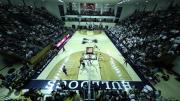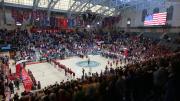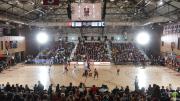In late February, the Ivy League announced a pre-determined rotation of campus sites for its basketball tournaments, and the response on social media and in the press was swift and critical. Penn’s star, AJ Brodeur, tweeted, “Big yikes.” Dalen Cuff, an ESPN commentator who played at Columbia, deplored the “rotational charade” on Twitter. The Philadelphia Inquirer’s Mike Jensen wrote: “My view of the Ivy League’s decision to play its postseason tournaments on every single campus, no matter how marginal its gym, before returning to the Palestra: It’s insane. Actually, it’s worse than that. It’s a vote against caring about basketball at all.”
The disparities in the league’s arenas are striking. For the last two years, the conference held its tournaments at the Palestra, Penn’s 8,722-seat arena, long-dubbed “the cathedral of college basketball.” None of the other Ivy arenas approaches the Palestra’s iconic status, and many are small. Harvard’s Lavietes Pavilion, the site of next year’s tournaments, seats 1,636—while attendance at last year’s tournaments was a combined 5,219 for the semifinals and a combined 5,564 for the finals.
Geography looms large, particularly for far-flung campuses like Cornell and Dartmouth. “Who is going to attend this tournament in Hanover, New Hampshire?” asks Kathy Orton, the author of Outside the Limelight: Basketball in the Ivy League. “There’s just not going to be that many people there.”
Some see deeper issues at play. Steve Bilsky, a former star point guard and athletic director (AD) at Penn, wrote in an email to Harvard Magazine: “The Ivy League is at its best when the 8 schools sacrifice their institutional self-interests for the good of the whole.…The league is at its worst when parochial interests dominate. While rotating the tournaments is no doubt ‘fair, onus,’ it sacrifices showcasing the product in the best manner to the public and media, as well as limiting participation by the fans.”
Harvard Magazine spoke with more than 25 alumni and journalists as well as current and former league officials, athletic directors, coaches, and players to gauge sentiment surrounding the tournaments and make sense of this decision. This reporting revealed a complex, consensus-driven decision-making process and a meticulous, sometimes uneasy, effort to balance institutional interests with social, commercial, and athletic issues. Was it ultimately for the greater good?
Holding the tournaments at the Palestra the first year was an easy decision. Says Ivy League executive director Robin Harris, “We had a crown jewel in the league that we needed to take advantage of.”
Many were happy to continue that custom, including Stemberg coach Tommy Amaker, who saw the arena as a way to cultivate the tournaments’ identity. “My three thoughts,” he says, “were to brand it, anchor it, and then grow it.” Cuff, the former Columbia player who now broadcasts the men’s tournament for ESPN, remembers the sense of history he felt playing in the building and calls it an ideal venue to showcase Ivy League basketball on national television.
And these days, television and commercial considerations have become increasingly important. In April 2018, the league signed a 10-year deal with ESPN to broadcast many events, including all basketball games. The conference has also become more open to commercial sponsorship. In 2016, it partnered with JMI Sports, its official marketing-rights agency. “We really felt that we were the last untapped resource in Division I Athletics,” Harris says. “We’re going to be very careful about the companies with which we choose to align. We’re going to make sure that they represent quality, positive values, and that they fit with the Ivy League.” The tournaments’ sponsors thus far have included Porsche, Citizens Bank, and TIAA.
Most ADs, on the other hand, supported changing the tournaments’ site. The Palestra, located at the southern edge of the league’s geographic footprint, is a challenge for some fans to get to—and it created a competitive advantage for Penn. Despite attempts to counteract that by awarding the home-team locker rooms to the highest seeds and installing the Ivy League logo at center court, the results were worrisome. In 2017, the Penn men, who finished 6-8 in the league, nearly knocked off 14-0 Princeton. Dartmouth coach David McLaughlin notes that holding the tournaments at the Palestra permanently would also give the Quakers a recruiting advantage. “The Palestra is a perfect place for the Penn Quakers,” says Yale’s James Jones. “It’s not a perfect place for everybody else.”
The ADs always knew that they might need to modify the tournaments. “We took a leap of faith, I suppose,” says former Yale AD Tom Beckett, “and asked for people to give this a chance. And to be candid with you, it was experimental.” Even so, the question of where to move the tournaments has been vexing. “We have spent, I think, more time on location than on any other issue related to the tournaments,” Harris says.
One option is giving home court to the higher seed. This mitigates concerns about an unearned home-court advantage, but would split the men’s and women’s tournaments. “How do you pick between two children?” says Princeton AD Mollie Marcoux Samaan. “In some schools, that would be an easy answer. That’s not an easy answer in the Ivy League. The ADs all support the women’s programs and the men’s programs. You want to show the same support for both.”
Another option is holding the tournaments at a neutral site. But playing the tournaments at Ivy League arenas reduces overhead costs, a significant consideration because of another norm: Ivy League schools, despite their sizable endowments, think twice about athletic investments. (Harris adds that the league wants to keep ticket prices reasonable, too.) Plus, Harry Sheehy, Dartmouth’s AD, says that a neutral site “almost has to be perfect in terms of location, size, the area. Is it a place people want to go? Those are all really important questions.”
Playing the tournaments at rotating campus sites presents its own tradeoffs. The drawbacks involving geography and capacity are real but intractable. Sheehy says, “I think we all wish we had a centrally located 4,000- to 5,000-person arena.” On the other hand, there is the benefit of an “Ivy League feel,” he adds, satisfying a “sense in the room that it should be an on-campus event.” Plus, each school expressed enthusiasm for hosting, as well as confidence in their ability to do so, Harris says. And many felt that rotating was fair, something that does matter in the Ivy League. Princeton coach Courtney Banghart says: “If you’re going to do it on anyone’s campus, it’s important that you do it on all of them.”
The tournaments and Ivy League basketball may end up changing in other ways, too. Among them, some suggest the possibility of lengthening the tournaments to three days to improve the times of women’s games. A committee of coaches and administrators is also examining potential shifts to the current regular-season schedule of back-to-back games on Friday and Saturday nights. (Several coaches emphasized the need to make changes deliberately and carefully, though, in part to avoid the corruption that is known to exist elsewhere in college basketball. For instance, Princeton coach Mitch Henderson, points to an FBI probe that has implicated many college basketball and Amateur Athletic Union programs across the country.)
One issue is not in question: the strength of Ivy basketball. The men and women rank among the top-11 conferences nationally; the teams include NBA and WNBA prospects; and many hope the tournaments will help the conference become a two-bid league for the men’s NCAA tournaments. (The women accomplished this in 2016.)
After 60 static years, Ivy League basketball made a major change in 2017 by creating the tournaments. Now it is adapting. “You tweak the things that need tweaking,” says Princeton’s Marcoux Samaan.
The rotating schedule for the tournaments may be a flop a few years from now, but that doesn’t mean the original decision was flawed. If anything, the Ivy League’s decision-making process—which considers increased national competitiveness as well as vital social, financial, commercial, and other concerns—is adding a dose of sanity to March Madness.











